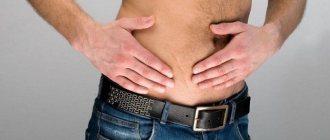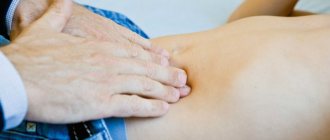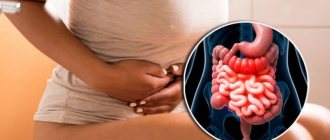Throughout life, a person repeatedly experiences abdominal pain. Under the age of 50, most often the cause of pain is not organic, but functional in nature, when drug therapy is most likely to be effective. The cause may be intestinal colic (in children in the first months of life), irritable bowel syndrome, biliary dyskinesia, dysfunction of the sphincter of Oddi, etc. About a third of cases of functional pain are accompanied by spasm of the smooth muscles of the gastrointestinal tract. This is why antispasmodics are so widely used without a doctor’s prescription. Providing a pronounced analgesic effect and normalizing the functioning of the organ, they, unlike non-narcotic and opioid analgesics, do not interfere with the mechanisms of pain, that is, they do not “erase” the picture of the disease, which is critically important in diagnosis.
Nota bene!
When a client asks for a remedy for abdominal pain, it is necessary to exclude urgent situations in order to send the sufferer to a doctor in time. These include:
- Severe pain that prevents you from sleeping or doing anything, lasts longer than 1-2 hours.
- Severe abdominal pain is accompanied by vomiting.
- Severe pain is accompanied by elevated body temperature - 38.5°C and above.
- Severe pain is accompanied by loss of consciousness.
- Severe abdominal pain in a pregnant woman.
- The abdominal muscles are tense and the stomach is as hard as a board.
- Diarrhea mixed with bright red blood.
- The stool is dark and tarry.
- Vomiting blood.
- Abdominal pain is accompanied by vomiting, diarrhea and severe dehydration.
General information
Pain that appears near the navel and moves to the lower right part of the abdominal cavity may indicate appendicitis - inflammation of the appendix (intestinal appendix). In most serious cases, surgery will be required to remove the appendix. With advanced appendicitis, the appendix may rupture. If you experience severe pain or tenderness in the right lower abdomen, abdominal pain when walking, nausea, vomiting or loss of appetite, or fever, you should consult a doctor immediately.
Pain in the lower left peritoneum can be a symptom of diverticulitis. Diverticulitis occurs when small ball-shaped capsules called diverticula form in the walls of the colon, which subsequently become infected and inflamed. Other symptoms of diverticulitis include fever, nausea, vomiting, chills, cramps and constipation. Treatment for diverticulitis usually involves clearing the colon of infection and inflammation. Your doctor may prescribe antibiotics and/or pain medications, a liquid diet, and bed rest for several days. In some cases, treatment for diverticulitis requires a hospital stay. If complications occur, surgery may be necessary. The best way to prevent diverticulitis is a diet rich in fiber. Dietary fiber promotes proper digestion and relieves pressure in the colon. Gradually increase the amount of fiber in your daily diet and drink plenty of fluids. Emptying your bowels on time will also help prevent diverticulitis. The accumulation of waste from the digestive system causes an increase in pressure in the colon.
Acute pain in the right hypochondrium, intensifying after eating, indicates the presence of gallbladder damage. Gallbladder diseases include stones and inflammation of the gallbladder (cholecystitis). If complications occur, gallbladder damage may have other symptoms, along with abdominal pain. These include: jaundice (yellowing of the skin and whites of the eyes), severe fever and chills. Sometimes people with gallstones experience no symptoms at all. If you experience regular pain in the right hypochondrium, you should consult a doctor. Gallbladder pain can be managed in a number of ways, ranging from simply waiting it out (observing symptoms for some time and not getting any treatment) to taking medications and even surgery. You can also reduce the symptoms of gallbladder disease by reducing the amount of fat in your diet.
Abdominal pain relieved by bowel movements and accompanied by diarrhea or constipation may indicate irritable bowel syndrome, a common gastrointestinal disorder with no known cause. When irritable bowel syndrome occurs, the intestinal walls contract too much, sometimes too little, sometimes too slowly, and sometimes too quickly. Symptoms of this disease include: bloating, increased gas production, slimy stools, and a constant desire to empty the bowels. This syndrome cannot be treated with surgery or medications. However, the condition can be prevented by drinking plenty of water, increasing the amount of fiber in your diet, reducing the amount of caffeine you consume, and increasing exercise.
Sharp, burning pain in the upper and middle abdomen (between the breastbone and belly button) may indicate the presence of an ulcer. An ulcer is a wound that forms in the tissues of the stomach or upper intestine. There are many causes of ulcers. Smoking, taking acetylsalicylic acid, ibuprofen or other non-steroidal anti-inflammatory drugs may play a role. An ulcer can also form if the stomach is unable to protect itself from strong stomach acids. Helicobacter pylori, a bacterium that lives in the stomach, can also cause ulcers. Stress and spicy foods cannot cause ulcers. Heartburn alone cannot indicate this disease. Severe pain like heartburn can also be caused by the less serious condition gastroesophageal reflux disease.
In women, abdominal pain may indicate problems with the reproductive system. Pelvic pain that occurs every month before menstruation may indicate endometriosis, a condition in which particles of tissue from the uterus move through the fallopian tubes and land on the ovaries, pelvis, bladder and other organs. Tenderness in the lower abdomen may indicate pelvic inflammatory disease (infection of the uterine tissue, fallopian tubes, or ovaries). In women of childbearing age, ectopic pregnancy can also cause sharp, sharp or stabbing pain in the peritoneum, accompanied by vaginal bleeding, irregular menstrual cycles and pain radiating to the shoulders. Ovarian cysts and uterine fibroids can also cause abdominal pain in women.
Other cases of abdominal pain include: urinary tract infections, food poisoning and allergies, hernia, kidney stones and lactose intolerance.
Cellular mechanism of pain
Smooth muscle cells are mainly found in the large intestine. There are significantly fewer of them in the small intestine. The mechanism of cell contraction depends on the concentration of calcium ions in the cytoplasm. The sources of calcium are the extracellular space, connected to the cytoplasm through calcium (slow) membrane channels, as well as the intracellular depot. The release of calcium causes the muscle cell to contract. The contraction of muscle cells forms a spasm and the person feels pain.
The process of muscle contraction is most often triggered by the mediator acetylcholine, binding to muscarinic cholinergic receptors (M-cholinergic receptors). Thus, blockade of M-cholinergic receptors leads to a decrease in tone and relaxation of smooth muscles (and therefore helps relieve abdominal pain). This, in particular, is the basis for the mechanism of action of a group of drugs called M-anticholinergics.
The interaction of calcium with calmodulin leads to the interaction of actin with myosin and cell contraction. CAMP (cyclic adenosine monophosphate) and cGMP (cyclic guanosine monophosphate) weaken the interaction of calcium with calmodulin and also impede the entry of calcium ions into the cell. The level of cAMP and cGMP is controlled by phosphodiesterase (PDE), which destroys excess of these nucleotides. Thus, if you reduce the activity of PDE, the concentration of calcium ions in the cytoplasm will decrease and the tone of the muscle cell will decrease.
Based on the described mechanisms for regulating the calcium concentration inside the muscle cell, which are disrupted under pathological conditions and lead to spasm, the main groups of antispasmodics have been created:
- M-anticholinergics (atropine, hyoscine butyl bromide).
- PDE IV inhibitors (drotaverine).
- Blockers of calcium release from intracellular stores or sodium channel blockers (mebeverine).
- Calcium channel blockers.
M-anticholinergics
M-anticholinergics are one of the oldest groups of drugs.
Atropine has been used in medicinal herbs since the 4th century BC. e. Thus, the ancient Greek naturalist Theophrastus described mandrake as a remedy for treating wounds, gout and insomnia, and also as a “love potion.” The ancient Greek military physician Dioscorides (1st century AD) described mandrake wine as an anesthetic to treat pain or insomnia, to be given before surgery or cauterization. M-anticholinergics most effectively affect the upper gastrointestinal tract. The use of non-selective M-anticholinergics (atropine, platyphylline, metacin) is limited by their prescription, as well as by the fact that they have a systemic effect and have a number of side effects, such as intestinal atony and obstruction.
One of the relatively oldest selective M-anticholinergics is hyoscine butyl bromide (first registered in Germany in 1951). It acts on the M1 and M3 subtypes of receptors, localized mainly in the walls of the upper gastrointestinal tract, gallbladder and biliary ducts. Hyoscine butyl bromide does not penetrate the blood-brain barrier and has a weak systemic effect, unlike atropine. However, it is contraindicated in people with glaucoma, benign prostatic hyperplasia, as well as organic stenosis of the gastrointestinal tract and tachyarrhythmias. Hyoscine butyl bromide accumulates in the smooth muscles of the gastrointestinal tract and is excreted unchanged by the kidneys. The drug is successfully used for sphincter of Oddi dysfunction, biliary dyskinesia and pyloric spasm.
The severity of the effect of hyoscine butylbromide also depends on the patient’s individual sensitivity to this drug. Unfortunately, the antispasmodic effect of hyoscine butyl bromide on the small intestine (except the duodenum) and large intestine can be realized when taking a dose 2–10 times higher than the therapeutic dose, so its use is useless for spasms in the lower abdomen. A large number of restrictions and risks when taking this drug require medical supervision, which is why the M-anticholinergics known to us are currently used less and less abroad. However, hyoscine butyl bromide is still available without a prescription.
Treatment of pain during menstruation
Pain is considered severe if it interferes with your daily activities, and such pain affects about 10% of women and is called dysmenorrhea. Remember, this is a serious symptom that is common to many conditions, including endometriosis or fibrosis, which means consulting a doctor is required.
Below are some ways to relieve period pain:
Regular physical activity and generally staying physically fit can reduce period pain. Pain relievers that reduce the effects of prostaglandins may help with menstrual pain. These painkillers include non-steroidal anti-inflammatory drugs (NSAIDs for short). Relaxation techniques, bed rest and simple measures such as applying heat to the lower abdomen (in the form of a warm water bottle or heating pad) can be very effective.
Phosphodiesterase inhibitors (PDE) type IV
These are traditionally widely used antispasmodics: drotaverine hydrochloride and papaverine. Their injectable forms are sold with a prescription, while their tablet forms are available without a prescription. PDE IV is widely present in smooth muscle along the entire length of the intestine, as well as in the biliary and urinary tracts. Thus, blocking PDE IV has a universal antispasmodic effect regardless of the severity of the spasm or its cause. In addition, drotaverine has anti-edematous and anti-inflammatory effects. Drotaverine can be used for acute abdominal pain - both to relieve acute spasms and for long-term treatment of biliary dyskinesia, cholelithiasis, chronic intestinal diseases with spastic syndrome, which are accompanied by colicky or bursting pain. Unlike M-anticholinergics, drotaverine can be used in elderly men with prostate pathology, as well as with concomitant pathology and combined use with other drugs. The therapeutic concentration of drotaverine in plasma when taken orally is achieved after 45 minutes.
What can you do for stomach pain?
Mild pain not associated with ulcers, diverticulitis, or gallbladder disease can be treated at home. You should give your body enough time to rest. To ease the pain, take simple painkillers or antispasmodics (drotaverine, paracetamol). Do not use acetylsalicylic acid or other anti-inflammatory drugs such as ibuprofen. Avoid alcohol and caffeine.
Do not use laxatives or give enemas.
Sodium channel blockers
These drugs block intracellular calcium stores through a cascade of reactions. The most famous drug is a derivative of veratric acid - mebeverine. Unlike anticholinergics, it does not cause hypotension of the colon. Most often, this drug is prescribed for functional disorders of the gastrointestinal tract or as an adjuvant for organic diseases of the gastrointestinal tract. Mebeverine is used only for course treatment. Mebeverine is most effective in combination with other pathogenetic drugs. Mebeverine is mainly available by prescription, but there is a dosage form in tablets that does not require a doctor's prescription.
We will not dwell on calcium channel blockers in more detail, since these drugs do not have any over-the-counter forms.
The over-the-counter myotropic antispasmodic trimebutine stands apart. Trimebutine acts on the enkephalinergic system of the intestine and peripheral opiate receptors - µ, κ and δ. Having an affinity for receptors that enhance and suppress peristalsis, it stimulates the contraction of intestinal smooth muscles in hypokinetic conditions and is an antispasmodic in hyperkinetic conditions. Trimebutine reduces the tone of the esophageal sphincter, promotes gastric emptying and increased intestinal motility, as well as the response of the smooth muscles of the colon to food irritants. It is used for various functional disorders of the gastrointestinal tract.
Ask and choose
How can a pharmacy client choose an over-the-counter antispasmodic from the extensive list of drugs for abdominal pain? Guiding questions will help:
- Does a person have a chronic organic gastrointestinal disease - peptic ulcer of the stomach or duodenum, chronic cholecystitis, chronic pancreatitis, biliary colic, biliary dyskinesia? As a rule, the patient already knows what helps him or what drug the doctor recommended for him during an exacerbation.
- Patient's age? Selective M-anticholinergics are not suitable for the elderly due to the risk of developing intestinal obstruction. Also, antispasmodics have age restrictions for children: mebeverine can be used from twelve years of age, hyoscine butylbromide and drotaverine - from six, trimebutine - from three.
- For women - pregnancy, lactation? The use of antispasmodics during pregnancy is possible only as prescribed by a doctor. PDE inhibitors and trimebutine are contraindicated during lactation. Anticholinergics and sodium channel blockers can be used during lactation.
- Pain in the upper abdomen, possibly accompanied by nausea or vomiting? A selective M-anticholinergic drug is suitable for adults, in the absence of contraindications described in the instructions for a particular drug.
- Pain in the lower abdomen? Type IV PDE inhibitors and sodium channel blockers are suitable.
Sources
- Abdominal pain syndrome in the practice of general practitioner T. M. Benz “News of medicine and pharmacy.” Gastroenterology (239), 2008.
- Pchelintsev M. V. “Anspasmodics: from clinical pharmacology to pharmacotherapy.” Attending Physician 7 (2008): 74–77.
- Mikhailov I. B. Clinical pharmacology (textbook for students of medical universities) - 5th ed., revised. and additional - St. Petersburg: publishing house "Sotis-Med", 2013. - 588 p.
- Yakovenko E. P., et al. "Opiate receptor agonist trimebutine in the treatment of functional disorders of the gallbladder and sphincter of Oddi." Journal "Attending Physician" 2–2014 (2017): 56.
- Tytgat GN. Hyoscine butylbromide: a review of its use in the treatment of abdominal cramping and pain. Drugs 2007; 67:1343–57.









